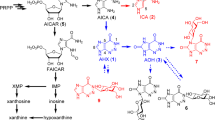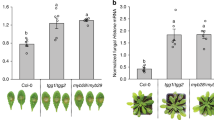Abstract
THAT the growth-promoting action of indole-3-acetonitrile is exerted on some plants but not on others is due to its conversion in the susceptible plants to indoleacetic acid1,2. The bioassays which made possible the original discovery of indoleacetonitrile in Brassica 3,4 were made on Avena coleoptiles, which were found1,2 to carry out the conversion powerfully. Coleoptiles of Zea mays evidently make the conversion weakly, seedlings of Lupinus or Pisum scarcely at all1. These facts suggested the presence in some plants of an enzyme system which carries out the conversion, and preliminary experiments led to the demonstration that a cell-free plant juice from Avena coleoptiles has this ability. For further work a number of plants was studied as possible sources of the enzyme, and leaves of Avena and Hordeum were found very active. Most of the subsequent experiments, including those described here, have been made with barley leaves and stems, Breck's six-row variety. The activity was assayed by incubating the juice with a known quantity of synthetic indoleacetonitrile for 4 hr., then acidifying the solution to pH 2.8 with H3PO4, shaking out with ether, treating the ethereal solution with saturated sodium bicarbonate and acidifying the latter and re-extracting. The ether extract was taken up in water and its indoleacetic acid content determined by the Salkowski reaction5. Earlier experiments had shown good agreement of the Salkowski indoleacetic acid determinations with results obtained from pea curvature and pea straight-growth bioassays, and with estimates from paper chromatograms.
This is a preview of subscription content, access via your institution
Access options
Subscribe to this journal
Receive 51 print issues and online access
$199.00 per year
only $3.90 per issue
Buy this article
- Purchase on Springer Link
- Instant access to full article PDF
Prices may be subject to local taxes which are calculated during checkout
Similar content being viewed by others
References
Thimann, K. V., Arch. Biochem. Biophys., 44, 242 (1953); Amer. Scientist, 589 (1954).
Stowe, B. B., and Thimann, K. V., Arch. Biochem. Biophys., 51, 499 (1954).
Henbest, H. B., Jones, E. R. H., and Smith, G. F., J. Chem. Soc., 3796 (1953).
Bentley, J. A., and Bickle, A. S., J. Exp. Bot., 3, 406 (1952).
Gordon, S., and Weber, R. P., Plant Physiol., 26, 192 (1951).
Author information
Authors and Affiliations
Rights and permissions
About this article
Cite this article
THIMANN, K., MAHADEVAN, S. Enzymatic Hydrolysis of Indoleacetonitrile. Nature 181, 1466–1467 (1958). https://doi.org/10.1038/1811466a0
Issue Date:
DOI: https://doi.org/10.1038/1811466a0
This article is cited by
-
Natural nitriles and their metabolism
World Journal of Microbiology & Biotechnology (1990)
-
A hypothetical route for the biogenisis of IAA
Planta (1966)
-
Indolacetamid?ein Intermediat der Indolessigs�urebildung aus Indolacetonitril bei der Alge Furcellaria
Planta (1965)
-
Untersuchungen über das Vorkommen und die Wirkungsweise von Indol-3-acetonitril in höheren Pflanzen
Planta (1962)
Comments
By submitting a comment you agree to abide by our Terms and Community Guidelines. If you find something abusive or that does not comply with our terms or guidelines please flag it as inappropriate.



